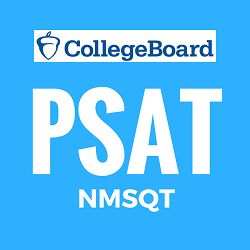The PSAT exam is the Preliminary SAT/National Merit Scholarship Qualifying Test (PSAT/NMSQT). It is offered by College Board. This test is taken in High School. Many students take the test in Sophomore and Junior year of high school. But only Junior year scores are considered for the National Merit Scholarship. The PSAT Test is taken only once a year in October. It’s a 2 hours and 45 minutes test. PSAT Max score is 1520. The test measures a student’s skills in two core areas: Evidence-Based Reading and Writing and Math, and is composed of three sections—Reading, Writing, and Math.
Table 1: Section of PSAT
| Section Group | # Question | Question Type | Time (Min.) |
| Reading | 47 | MCQ | 47 |
| Writing | 35 | MCQ | 35 |
| Math | 48 | MCQ + Grid-in | 70 |
| Math Calc | 27 + 4 = 31 | MCQ (27) + Grid-in (4) | 45 |
| Math No Calc | 13 + 4 = 17 | MCQ (17) + Grid-in (4) | 25 |
- Composite Scoring Section:
- Evidence-Based Reading and Writing (EBRW)
- Math Composite
What to expect in PSAT Math?
Table 2: Math Section of PSAT
| Areas in Math | # of Questions | Topics |
| Heart of Algebra | 16 | System of equations, Inequalities, etc. |
| Problem Solving and Data Analysis | 16 | Ratios, proportions, percentages, and units, etc. |
| Passport to Advanced Math | 14 | Polynomials, Higher-order equations, etc. |
| Additional Topics in Math | 2 | Data interpretation, statistics, etc. |
What to expect in PSAT Reading?
Table 3: Reading Section of PSAT
| Passage type | # of Question | No. of passage |
| U.S. and World Literature | 9 | 1 |
| History/Social Studies | 9 -10 | 1 or 2, 1 pair |
| Science | 9 -10 | 1 or 2, 1 pair |
The multiple-choice questions for each passage type will be arranged in order from the more general to the more specific so that you can actively engage with the entire passage before answering questions about details.
Table 4: US and World Literature + History & Social studies + Science
| Information and Ideas | Close reading. Citing textual evidence. Determining central ideas and themes | Cover 35% |
| Summarizing | Understanding relationships.Interpreting words and phrases in context | Cover 28% |
| Rhetoric | Analyzing word choice. Assessing overall text structure, assessing part-whole relationships. Analyzing point of view, determining purpose, analyzing arguments. | Cover 17% |
| Synthesis | Analyzing multiple texts. Analyzing quantitative information | Cover 20% |
What to expect in PSAT Writing and Language?
Table 5: Writing and Language of PSAT
| Subject areas | Passage Topics |
| Careers | Hot topics in “major fields of work” such as information technology and healthcare |
| Humanities | Arts and letters |
| History/Social Studies | Discussion of historical or social sciences topics such as anthropology, communication studies, economics and etc. |
| Science | Exploration of concepts, findings, and discoveries in the natural sciences including Earth science, biology, chemistry, and physics |
The question types on the PSAT Writing and Language Test can be broadly categorized as follows:
| Expression of Ideas | 24 questions | DevelopmentOrganization, and effective language use | Cover 55% |
| Standard English Conventions | 20 questions | Sentence structure.Conventions of usage.Conventions of punctuation | Cover 45% |
If you already know about PSAT and preparing for the upcoming PSAT test, then check the Socrato youtube channel for Practice Test scoring and diagnostic report.










